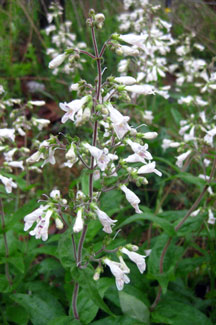Resource Library
Plant of the Week: Beardtunge, Arkansas
The University of Arkansas System Division of Agriculture does not promote, support or recommend plants featured in "Plant of the Week." Please consult your local Extension office for plants suitable for your region.
Plant of the Week
Arkansas Beardtungue
Latin: Penstemon arkansanus

I just returned from a week in the Idaho mountains where I attended the American Penstemon Society meeting and added another 10 species of penstemons to my life list. To the non-plant people we meet on our field trips, we no doubt appear a bit odd as we slither about on our bellies photographing each new find, but you don’t have to travel so far to see penstemons. Penstemon arkansanus. Arkansas beardtongue, is a home-grown species that blooms in the early part of summer.
Amongst academic plant scientists, penstemons garner a great deal of research because they represent a newly evolving group of plants, probably less than 10 million years old. To scientists interested in how new species of plants arise they make a good case study to look at speciation and tease out what species may have hybridized to give rise to a new and unique species. To evolutionary biologists, they provide a good case study to see how environment influences plant morphology and adaptation.
Arkansas beardtongue is an herbaceous perennial now classified as a member of the plantain family but most books and classical taxonomists put it in the snapdragon family. It is one of six to eight species native to the state. Depending on the authority, there are from 250 to 400 species of penstemons, all of which are native to North America.
The Arkansas beardtongue grows to about 2 feet tall when in flower with a basal rosette of dark olive-green leaves to 4 inches long. he stems are usually purplish in color and often pubescent. Stem leaves are opposite, pointed at the tip, sparsely toothed and partially clasping the stem.
Flowers appear from late April through early June with this species the first of the penstemons to bloom. Individual inch-long tubular flowers are white with fine purple lines inside the throat. Flowers are produced at the ends of the stalks in compact clusters with many flowers open at one time. The name beardtongue is used for penstemons because in some species sterile stamens are covered with tufts of small white hairs.
Arkansas beardtongue is native throughout the Ozarks and most of Arkansas except the Delta region and the Gulf coastal plains. It is also found in the southern Missouri Ozarks and parts of eastern Oklahoma and east Texas. It favors dry, well-drained sites in the open woods where it often forms fairly large colonies. This species was first described in 1922 from specimens collected in Arkansas by Francis Pennell (1886 – 1952), a Pennsylvania born botanist who worked for the New York Botanical Garden.
Arkansas beardtongue is not common in the nursery trade so is seldom seen in gardens. Like most penstemons it is not especially difficult to grow from seed that should be collected in late summer before the pea-sized capsules split and disperse the seeds. If greenhouse space is available the seeds can be planted in January with plants ready to set out in May. Otherwise, sow the seeds in a pot in May out of doors where they can be kept watered until germination occurs. Transplant seedlings when they are large enough to handle and grow them during the summer in quart size nursery pots. Transplant the plants to a sunny, well-drained site in the rock garden in the fall. The first blooming should occur the following spring. Penstemon plants tend to be short lived, persisting only three or four years, but if they are well sited they should perpetuate themselves by reseeding.
By: Gerald Klingaman, retired
Retired Extension Horticulturist - Ornamentals
Extension News - July 3, 2013
The University of Arkansas System Division of Agriculture does not maintain lists of retail outlets where these plants can be purchased. Please check your local nursery or other retail outlets to ask about the availability of these plants for your growing area.